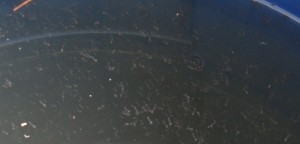16 July 2013 (13:47 UTC-07 Tango)/08 Ramadan 1434/25 Tir 1391/09 Ji-Wie (6th month) 4711
On 15 July parts of eastern Idaho got hit with summer rain storms. Not unusual, but what was unusual for me is that the next day I found one of my rain barrels swarming with Mosquito larvae. This was the first time. My research revealed that the publicly accepted idea that mosquitoes ‘breed’ in standing water is not necessarily true, especially for the West Nile Virus carrying Aedes genus.

Thousands of mosquito larvae (pupa?) in a 30+ gallon rain barrel, less than one day after an Idaho rain storm.
The Idaho Department of Health and Welfare states “Remove standing water around your home – this is where mosquitoes like to breed”. It turns out that it depends on the genus of the bloodsucker. Most will lay eggs on the surface of water, like the Culex mosquito, which is present in Idaho and carries West Nile and encephalitis.
Some mosquitoes lay their eggs on the underside of leaves.
Most species of Aedes mosquitoes lay their eggs in damp dirt, or near a pond’s edge, not directly in the water. Aedes also carry West Nile and versions of encephalitis.
I was interested to know why one of my rain barrels were swarming with larvae (possibly pupa?), less than one day after a rain storm, yet none of the drinking water buckets and pans for the dogs and cats were infected, even though they’ve been sitting for a few days. The animal’s water buckets were filled with city water, which is treated with chlorine and contains fluoride. That could be one reason, but I was concerned because this was the first time I’ve found any of my rain barrels swarming with mosquitoes.
It was also concerning to find the larvae swarm as I’ve seen only one adult mosquito (and been bitten twice) so far this year.
That particular rain barrel had a layer of damp dirt in the bottom, after a previous rain storm washed collected dust and dirt from the roof and rain gutter. Where I live people will tell you that it rains dirt here (it’s one reason why the car wash business does well here, and the car dealers really hate it when it rains). So, I suspect an Aedes mosquito laid eggs in the damp dirt at the bottom of the barrel, then the 15 July rainstorms flooded the barrel, hatching the eggs.
Not to worry, the water in my rain barrels are used ASAP after rain storms to water my pathetic vegetable garden, and my fruit trees (and now I rinse out the dirt). I also learned that Aedes eggs can hatch independently; if there is not enough water to hatch all of them some will enter a state of suspended animation until more water comes along.
What this means is that the claim that removing standing water to fight West Nile Virus depends on which vampire mosquito your fighting. The Aedes will lay eggs even if there is no standing water, they just need damp dirt. The eggs will lay in wait until a sudden large amount of water, like from a rain storm or a pond/lake/river overflowing its banks, will hatch the eggs. So, it would help to keep the area around your home clean and dry.
In western Idaho, West Nile Virus has been detected in Ada, Canyon and Payette counties. State health officials on that side of the Gem State report that they trapped Culex mosquitoes, and they tested positive for the virus. Officials are blaming the hot summer temps.